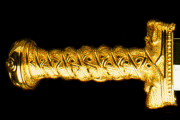Jeremiah’s Mountain
The Second Book of Maccabees reveals were the Ark was hidden – in a cave on "the mountain where Moses went up and saw the inheritance of God". In the Old Testament, Moses leads the Israelites out of Egyptian captivity and, after forty years in the wilderness, they enter what the Bible calls the "Promised Land" of Canaan. Moses never sets foot in Canaan himself but, just before he dies, he climbs a mountain where he has a vision of the Promised Land and reveals the last of God's commandments to the Israelites. The Promised Land of Canaan, it seems, is what is implied by the words "inheritance of God" in the Book of Maccabees account. Nearly every guidebook to the Holy Land confidently informs the reader that Moses’ vision of the Promised Land occurred on Mount Nebo, modern Jebel en Neba, ten miles east of the northern end of the Dead Sea: a site which is now in the kingdom of Jordan. However, this location seems more for the sake of tourism than having been derived from biblical research.

There are three Old Testament accounts of Moses’ vision of the Promised Land, found separately in the books of Leviticus, Numbers and Deuteronomy, and they each provide different locations for the event: on mounts Nebo, Abarim and Sinai. The Deuteronomy account actually gives two locations, naming both Mount Abarim and Mount Nebo as the mountain in question. Deuteronomy 32:49 refers to God instructions to Moses to climb the mountain:
Get thee up unto this mountain Abarim, unto mount Nebo, which is in the land of Moab, that is over against Jericho.
The author seems to have thought that the two mountains were the same, whereas, in fact, Mount Nebo is modern Jebel en Neba, ten miles east of the northern end of the Dead Sea, while Mount Abarim is modern Jebel el Hamra, some twenty miles further south. The author not only wrongly assumed that Abarim and Nebo was the same mountain, he also appeared to believe that the site in question was near Jericho, which was actually miles from either location. Mount Nebo was nineteen miles from Jericho and Mount Abarim was nearly thirty miles away. It seems that the author was totally unfamiliar with the area. Whoever he was, he must have been writing years after the event and in a different country.
Although the Numbers account of the same event is less confusing, only naming Mount Abarim, when summarizing the episode in the final verse of this book, the author also reveals that he is equally unfamiliar with the topography of area:
These are the commandments and the judgments, which the Lord commanded by the hand of Moses unto the children of Israel in the plains of Moab by Jordan near Jericho. (Numbers 36:13)
In this verse the author mistakenly places Jericho in the land of Moab. Moab was a foreign kingdom to the east of the River Jordan, while Jericho was to the west of the river - well inside ancient Canaan.
The same account is found in the book of Leviticus, which also summarizes the event in its last verse. Here it takes place on Mount Sinai, which was somewhere in the Sinai Wilderness, to the south of the Dead Sea.
As both the Deuteronomy and Numbers accounts contain geographical mistakes that did not appear in the book of Leviticus, the Leviticus account of the event occurring on Mount Sinai seems the most likely. Indeed, Mount Sinai would seem the logical place where the Ark would have been hidden – this was where it had been made. Moreover, the Ark was the Hebrew’s most sacred possession which, from the time of King Solomon, had to be kept on only the most sanctified ground. God himself was believed to have instructed the Jerusalem Temple to be built especially to house it. Before that time, the most sacred Hebrew site was Mount Sinai. In Jeremiah’s time, with the temple threatened, Mount Sinai would be the next logical choice for the Ark’s resting place.
These are the commandments, which the Lord commanded Moses for the children of Israel in mount Sinai. (Leviticus 27:34)

On the mountain, Moses reveals the last of God's commandments to the Israelites.
Canaan and Moab at the time of the Exodus, showing the locations of Mount Nebo and Mount Abarim.









